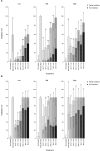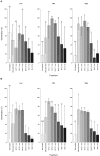Intraspecific Variation Along an Elevational Gradient Alters Seed Scarification Responses in the Polymorphic Tree Species Acacia koa
- PMID: 34804080
- PMCID: PMC8601391
- DOI: 10.3389/fpls.2021.716678
Intraspecific Variation Along an Elevational Gradient Alters Seed Scarification Responses in the Polymorphic Tree Species Acacia koa
Abstract
Physical dormancy in seeds can challenge restoration efforts where scarification conditions for optimal germination and seedling vigor are unknown. For species that occur along wide environmental gradients, optimal scarification conditions may also differ by seed source. We examined intraspecific variation in optimal scarification conditions for germination and seedling performance in koa (Acacia koa), which occurs across a wide range of environmental conditions. To evaluate scarification responses, we recorded imbibition percentage, germination percentage, germination time, seedling abnormalities, early mortality, seedling growth, and seedling survivorship. From these, we developed a scarification index (SI) that integrates these measures simultaneously. We hypothesized that seeds from lower elevation sources exposed to higher temperatures would have harder seed coats and would require more intense scarification treatments. To test this hypothesis, we repeatedly exposed seeds to hot water differing in temperature and time until seeds imbibed. Supporting the hypothesis, seeds from lower elevation sources generally required more intense scarification, although we found substantial variation among sources. Koa seeds germinated in about a week following imbibition. Boiling seeds (i.e., maintaining at 100°C) was effective for imbibing seeds but it also substantially reduced germination percentages. Repeated exposure to 90 to 100°C water did not reduce germination percentage but decreased seedling performance and increased early mortality. No seeds remained unimbibed after six attempts of boiling germinated whereas seeds remaining unimbibed after 15 attempts of exposure to 90 to 100°C water showed high germination percentages. Abnormalities in seedling development were rare but increased with treatment intensity. Exposure to 100°C water for 1 min overall generated the best SI values but the best treatment differed by elevation, and the treatment with the best SI was rarely predicted from the highest germination percentages. Seeds that imbibed without any treatment germinated at the same level as manually filed seeds but produced poor seedling quality. Variation in mother tree environments along an elevational gradient can lead to differences in seed coat characteristics, which may explain differing responses to treatments. Scarification treatments affected processes beyond imbibition and germination and using an index like SI may improve efficiency by identifying optimal scarification treatments while reducing seed waste.
Keywords: Hawai'i Island; elevational gradient; forest restoration; germination; hot water treatment; imbibition; mother tree; scarification index (SI).
Copyright © 2021 Sugiyama, Friday, Giardina and Jacobs.
Conflict of interest statement
The authors declare that the research was conducted in the absence of any commercial or financial relationships that could be construed as a potential conflict of interest.
Figures





Similar articles
-
Some like it hot: Seed thermal threshold variation in obligate seeding Acacia pulchella along a climate gradient.Sci Total Environ. 2024 Oct 20;948:174929. doi: 10.1016/j.scitotenv.2024.174929. Epub 2024 Jul 20. Sci Total Environ. 2024. PMID: 39038678
-
Effects of freezing temperatures on early life stages of native trees of different elevational origin: implications for tree recruitment in seasonally dry mountain forests.Plant Biol (Stuttg). 2024 Jan;26(1):63-73. doi: 10.1111/plb.13590. Epub 2023 Nov 16. Plant Biol (Stuttg). 2024. PMID: 37971789
-
The impact of chemical and hormonal treatments to improve seed germination and seedling growth of Juniperus procera Hochst. ex Endi.PeerJ. 2024 Apr 10;12:e17236. doi: 10.7717/peerj.17236. eCollection 2024. PeerJ. 2024. PMID: 38618572 Free PMC article.
-
Seed enhancement technologies for sustainable dryland restoration: Coating and scarification.Sci Total Environ. 2023 Dec 15;904:166150. doi: 10.1016/j.scitotenv.2023.166150. Epub 2023 Aug 17. Sci Total Environ. 2023. PMID: 37595910 Review.
-
Seed germination and vigor: ensuring crop sustainability in a changing climate.Heredity (Edinb). 2022 Jun;128(6):450-459. doi: 10.1038/s41437-022-00497-2. Epub 2022 Jan 10. Heredity (Edinb). 2022. PMID: 35013549 Free PMC article. Review.
References
-
- Allen J. A. (2002). Acacia koa A. Gray, in Tropical Tree Seed Manual, ed J. A. Vozzo (Washington, DC: USDA Forest Service, Agriculture Handbook 721; ), 253–255.
-
- Aref I. M., El Atta H. A., Al Shahrani T., Mohamed A. I. (2011). Effects of seed pretreatment and seed source on germination of five Acacia spp. Afr. J. Biotechnol. 10, 15901–15910. 10.5897/AJB11.1763 - DOI
-
- Ares A., Fownes J. H., Sun W. (2000). Genetic differentiation of intrinsic water-use efficiency in the Hawaiian native Acacia koa. Int. J. Plant Sci. 161, 909–915. 10.1086/317559 - DOI
-
- Baker P. J., Scowcroft P. G., Ewel J. J. (2009). Koa (Acacia koa) Ecology and Silviculture. General Technical Report. Albany, CA: United States Department of Agriculture Forest Service Pacific Southwest Research Station. 10.2737/PSW-GTR-211 - DOI
-
- Banko P. C., Peck R. W., Yelenik S. G., Paxton E. H., Bonaccorso F. J., Montoya-Aiona K., et al. . (2014). Dynamics and Ecological Consequences of the 2013-2014 koa Moth Outbreak at the Hakalau Forest National Wildlife Refuge. Technical Report HSCS-058, Hawai'i Cooperative Studies Unit, University of Hawai'i at Hilo, Hilo, Hawai'i.
LinkOut - more resources
Full Text Sources

